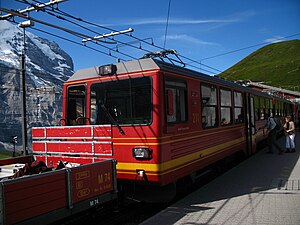JB BDhe 4/8
| BDhe 4/8 | |
|---|---|
| Numbering: | 211-218 |
| Number: | 8th |
| Manufacturer: | SLM / ABB (211–214) Stadler Altenrhein (215–218) |
| Year of construction (s): | 1992/93 (211-214) 2002 (215-218) |
| Axis formula : | 2'z 2'z + 2'z 2'z |
| Gauge : | 1,000 mm |
| Length over coupling: | 31,350 mm |
| Height: | 3,350 mm |
| Width: | 2,630 mm |
| Service mass: | 44.8 t 48.5 t after retrofit |
| Top speed: | 27 km / h (uphill) 17.5 km / h (downhill) at maximum incline |
| Hourly output : | before retrofit 804 kW |
| Continuous output : | after retrofit 1200 kW |
| Gear system : | Strub |
| Power system : | 1125 V / 50 Hz ∆ |
| Power transmission: | Overhead line |
| Number of traction motors: | 4th |
| Seats: | 104 + 14 folding seats |
BDhe 4/8 are railcars of the Swiss Jungfrau Railway (JB). They were procured in 1992 because some passengers in the old BDhe 2/4 had to take standing places due to a lack of space.
technology
Like the BDhe 4/8 of the Wengernalp Railway , on which their construction is based, they consist of two closely coupled, almost identical vehicle halves made of steel boxes with corrugated side walls. The uphill side of the vehicle consists of a driver's cab followed by a passenger compartment, an entrance with swinging doors and another passenger compartment. The vehicle half on the valley side is constructed in the same way with the only difference that it has only one pair of pantographs on the roof, while there are two on the mountain side, and that there is a luggage compartment between the driver's cab and the passenger compartment. In return, the adjacent passenger compartment is smaller than the one on the mountain side. There are side transition doors on the fronts and snow plows underneath. All four bogies, two of which are located under one half of the vehicle, are identical and can therefore be interchanged. On the axis of each bogie on the valley side is a transverse motor. All railcars are equipped for pure cog railway operation and, like their predecessors, the BDhe 2/4 , cannot run on an adhesion railway . In addition to the pantographs, only the braking resistors are on the roof. The clutches are automatic and, due to safety regulations, there are three independent braking systems. In contrast to the BDhe 2/4 (which are equipped with asynchronous motors) these railcars are originally equipped with direct current motors. A controlled three-phase rectifier supplies them from the three-phase network. In 2012, the front lighting was converted from light bulbs to LED lights.
Retrofit
New three-phase / three-phase traction equipment will be installed between 2012 and 2017. It corresponds to the equipment of the low-floor articulated railcars Bhe 4/8 221-224 and allows the speed to be increased to 33 km / h when driving uphill. This reduces the cycle time for the entire route from 2 to 1.5 hours.
business
The BDhe 4/8 usually drive in double traction and could previously also be remotely controlled from a boiler control car if required. However, this was canceled in 2012. The undercarriage is now in the depot on Kleine Scheidegg without any assembly.
advertising
Since June 2017, the 212 railcar has been available for the first time at JB with full advertising for ABB , the long-term technology partner of Jungfrau Railways.
Sibling vehicles
The Bhe 4/8 of the Gornergratbahn are almost identical to the BDhe 4/8 with the difference that the Bhe 4/8 only have access doors on one side and the different Abt gear system.
swell
- Hans-Bernhard-Schönborn: Swiss locomotives . GeraMond, 2004, ISBN 3-7654-7176-3 , pp. 60-61 .
- Swiss Railway Review 4/2016, pp. 180–182
Individual evidence
- ↑ Jungfrau Railway JB rolling stock directory. (PDF, 71 KB) Jungfrau.ch, October 2016, accessed on June 16, 2017 .
- ↑ World premiere: Jungfrau Railway for the first time in ABB design. Bahnonline.ch, June 13, 2017, accessed on April 16, 2018 .
